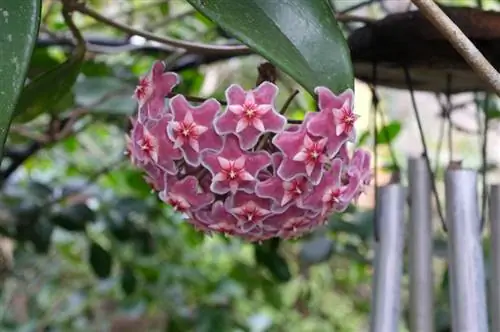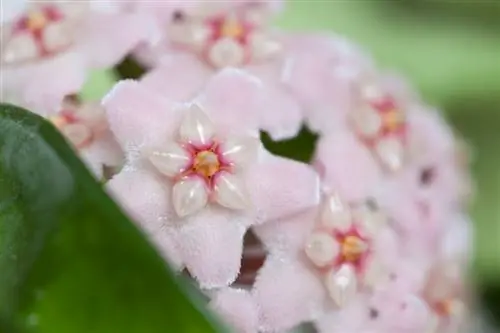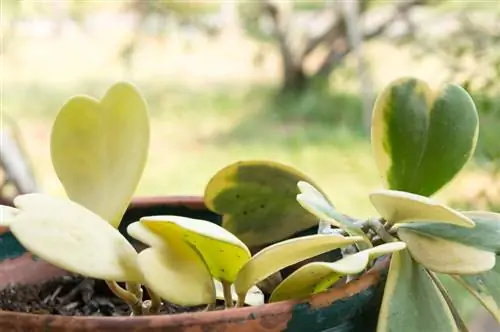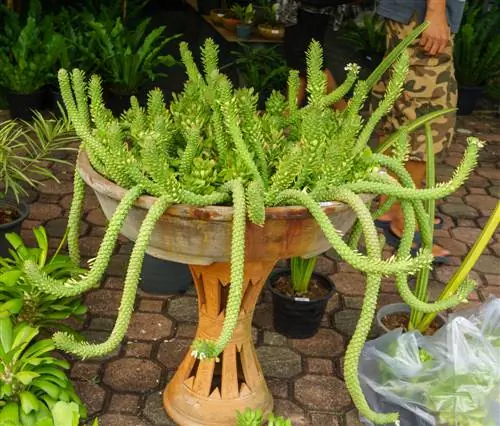- Author admin [email protected].
- Public 2024-01-02 03:03.
- Last modified 2025-06-01 06:02.
The porcelain flower has now become a rarity on the window sills of plant lovers. The tropical beauty from the Far East has a lot to offer visually, olfactorily and in terms of design. In addition, it is not particularly maintenance-intensive.
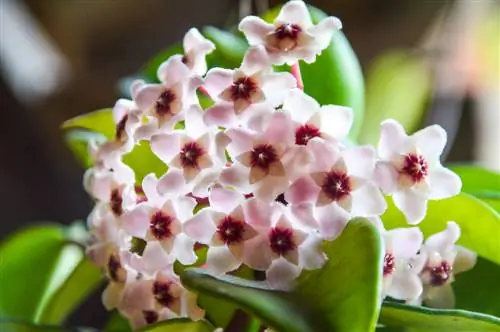
What should you know about porcelain flowers (Hoya)?
The porcelain flower (Hoya) is a tropical plant from Far Asia, Australia and Oceania. It prefers warm, bright locations, but cannot tolerate direct sun. Easy to care for and attractive, it flowers from spring to autumn, often fragrant but secreting sticky nectar. Popular varieties include: Hoya carnosa, Hoya kerrii, Hoya bella, Hoya australis and Hoya linearis.
Origin
The porcelain flower or wax flower, scientifically Hoya (named after the English gardener Thomas Hoy), is a plant from the tropics and subtropics of the Far East. Their home range spans relatively wide areas of Asia, Australia and Oceania - the various Hoya species naturally occur in China, Vietnam and Thailand, Japan, East India and Indonesia and inhabit both tropical rainforests, dry forests, coastal areas and Altitudes of up to 2500 meters.
- Natural area of origin: Far Asia, Australia and Oceania
- Habitats in tropical to dry forests, coastal and high altitude areas
Growth
The porcelain flower is an epiphyte, i.e. an epiphyte that chooses other plants in the wild as a growing ground. Like orchids and bromeliads, they prefer to grow on trees. In terms of growth, it develops quickly and forms flexible shoots - this makes the porcelain flower also well suited for espalier or arched cultivation. The fact that most species are climbers also makes the wax flower ideal for climbing on scaffolding and railings. Over time, the shoots become more or less woody.
- Actually epiphyte
- Fast growth, flexible shoots suitable for shaping
- Many climbing varieties - suitable for climbing
Bloom

Hoya gets its nickname wax flower from the mostly fleshy and waxy nature of its flowers. They appear in racemose (mock) umbels with small, star-shaped individual flowers, which form a very pretty structure thanks to their five-pointed sepal and petal combination. It's also nice that the porcelain flower blooms again and again from spring to autumn. Many species also exude a sweet, sometimes heavy scent in the evening hours. The nectar that the flowers secrete and that sticks to the windowsill is less beautiful.
Characteristics of Porcelain Flower Bloom:
- Small, racemose umbel inflorescences with an attractive star structure
- Often sweet, heavy scent
- Secretes nectar that drips and sticks
Location
According to its origin, the wax flower likes it warm and bright. However, it does not tolerate full sunlight well - after all, it thrives in woody habitats in its homeland. As with all exotic ornamental plants from warmer regions of origin, you cannot cultivate the porcelain flower outdoors in our latitudes. It is therefore best kept as a houseplant.
The substrate should be loose and permeable to air and water - it is best to create drainage with expanded clay in the pot. This will prevent the roots from suffocating or becoming waterlogged - they don't like that at all.
Pouring
Too much watering is taboo with the porcelain flower. However, you should still give it water regularly, especially during the vegetation phase. But make sure that the pot ball is completely dry before the next watering. As a tropical to subtropical plant, the porcelain flower also likes a shower or two: spray its leaves with a refreshing mist of water every now and then.
Note:
- Water regularly, but avoid waterlogging at all costs
- Regular showering is highly recommended
Fertilize
The porcelain flower can be fertilized with a moderate dose. You should use a rather weak green plant fertilizer (€11.00 on Amazon), which you mix with the irrigation water. However, this is not necessary more often than every 3-4 weeks. The risk of over-fertilization is certainly greater than weak growth or flowering due to a lack of nutrients. There is no fertilization at all in winter.
Transplanting
You do not have to and should not repot the porcelain flower too often. She doesn't like being disturbed on her feet just as much as she doesn't like constant changes of location. So only repot them if it is absolutely necessary, that is, if the pot becomes too small. The new pot should not be disproportionately larger than the old one - that would mean too much getting used to and increase the risk of weak leaves and flowers. Provide the new substrate with expanded clay drainage and, if necessary, some sand.
Wintering
In winter, when the porcelain flower does not have enough light for normal vegetation, you should give it a rest period. However, the general rule is that the difference in location compared to the summer location should not/must not be too high. The winter quarters should also be relatively bright and not too cold.
While the optimal temperature for the porcelain flower is between 18 and 23°C in summer, it should not fall below 10°C in winter. Of course, it must not be exposed to frost under any circumstances. But it shouldn't be too warm either, as that is not compatible with the inevitable lack of light. In addition, the risk of pest infestation increases in warm temperatures. A good winter location for the porcelain flower is, for example, a window seat in an unheated stairwell.
You should only water the porcelain flower moderately in winter, depending on its reduced vegetation.
The wintering rules:
- Bright location
- Temperature between 10 and 14°C
- Watering moderately
Cutting
Apart from the dead inflorescences during the summer, you can cut back the wax flower relatively easily. If shoots become excessively long, they can be trimmed without major losses. You should make sure to always place the scissors directly above a leaf axis. This is where the plant can best sprout again. By regularly shortening the shoots, you can keep the wax flower compact or in a special shape.
In general, you should also carry out thinning cuts regularly to increase flowering.
Not blooming
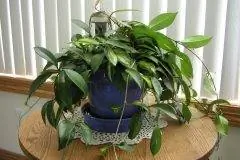
A relatively common problem in porcelain flower culture is the failure of the popular flowers to bloom. If certain care errors are made, the wax flower can be a bit sensitive. The most likely scenario for a poor bloom or no bloom at all is:
- Frequent change of location
- Too dark location
- Cutting off spent inflorescences
Above all, the porcelain flower does not like changes of location. So, right from the start of cultivation, make sure to find a suitable, sufficiently bright place with, if possible, no drafts. If you wait in vain for the flower to bloom, moving to another location is usually counterproductive.
What can also prevent the porcelain flower from blooming is a location that is too dark. The tropical plant needs a lot of light to produce its flowers. In this case, a change of location to a brighter parking space is of course unavoidable.
You should also under no circumstances cut off the dead inflorescences. This will prevent new flowers from forming in these same places. If you leave it alone, the porcelain flower will soon give you a new cluster of its small, waxy star flowers, provided it is not autumn yet.
Propagate

The wax flower is best propagated using planters. You can also cut cuttings, an explanation of this method is provided below.
With the sinking method, you lower a tendril of the mother plant into a pot with sandy, loose soil. It's best to do this in spring when the light availability increases. Remove the leaves at the rooting point and cut off the shoot tip. A uniform, moist, warm environment is particularly conducive to growth - to create this, it is best to use the tried and tested foil method. Keep the sinker permanently moist, but don't water too much here either.
As soon as roots have formed at the support point, you can cut the connection to the mother plant.
Poisonous
The toxicity of the porcelain flower is a somewhat nebulous matter - on the one hand, there are sometimes different information about it from experts. On the other hand, it also depends on the respective species. Some are slightly poisonous - in particular, people often warn against leaving cats, dogs and especially birds alone with the wax flower. But even small children shouldn't necessarily play unsupervised near porcelain flowers.
Pests
Fortunately, porcelain flowers are relatively insensitive to diseases and pests. If there are problems with growth or flower formation, this is usually due to an unpopular change of location, over-fertilization, waterlogging or other care errors.
Nevertheless, the wax flower can also be attacked by pests, especially during the overwintering phase when it is slightly weakened. As a preventive measure, especially during this time, make sure to protect them from unfavorable conditions. Aphids, scale insects and mealybugs are most common on the porcelain flower.
If you have an aphid infestation, you should first spray it off. For scale insects, the best thing to do is to add some nettle, garlic or tansy to the spray mixture. The best way to combat mealybugs is to remove infected parts of the plant and treat the plant with a solution of alcohol, soap and water.
offshoot
In addition to the casual lowering method, you can also use the well-known cutting method to get a new porcelain flower. In most cases this works without any complications. As with the lowering method, the time for growing cuttings is spring.
You get a cutting in the form of a shoot cut off above a leaf axis - so you can also use the clippings during one of the regular pruning sessions. Place the cutting in either a water glass or in one Allow the soil substrate to root. With the water glass method, you should change the water every now and then to avoid the risk of rot. You can add some rooting hormone to a soil substrate.
Varieties
The wax flower genus is extremely rich in species - no wonder given the variety of habitats of origin across the entire tropical and subtropical Far Asian region. In total there are around 200 different species. For a long time, only Hoya carnosa with its flesh-colored flowers was used as a pot plant. The range of pot cultivation has now expanded considerably. Here is an overview of particularly popular varieties:
Popular varieties
- Hoya carnosa
- Hoya kerrii
- Hoya bella
- Hoya australis
- Hoya linearis
Hoya carnosa
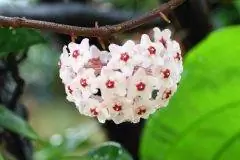
The Hoya carnosa is named for its pink to flesh-colored flowers. This quite unusual color makes it an attractive decoration on the windowsill or in the winter garden. The flower umbels are standing or slightly hanging and exude a very strong scent. However, they also secrete a lot of nectar.
The Hoya carnosa forms soft, later woody and climbing shoots that are covered with fleshy, shiny leaves. In total it can reach a height of up to 4 m.
It needs a bright location without too much direct sunlight; in winter it should be relatively cool, i.e. not above 14°C.
Hoya kerrii
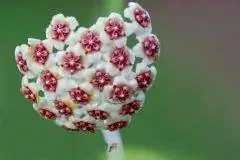
This variety also owes its name to a visual peculiarity: its heart-shaped leaves. Recently, the Hoya kerrii has been enjoying growing popularity, perhaps also because of the Valentine's Day culture that has been resurgent for years. The leaves also have the property that they can be rooted individually. A simple leaf cutting is therefore particularly suitable as a heartwarming souvenir. However, whether the heart leaf sprouts is very individual and can take up to 6 years!
The Hoya kerrii prefers a sunny to partially shaded spot - compared to other Hoyas, it can cope with relatively little light.
The flowers of Hoya kerrii are white with contrasting red petals and appear between May and October. It forms long, climbing shoots that should soon be guided by a climbing aid. Overall, the heart leaf porcelain flower only reaches a height of around one meter.
Hoya bella
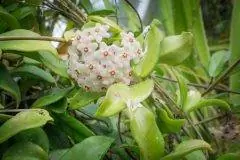
The Hoya bella is characterized by its elongated, cone-shaped leaves, which create an interesting structural effect. Its rich branching makes the Hoya bella perfect for compact shrub structures. However, it can also be cultivated as a hanging plant without increased pruning. Overall, it is one of the smaller varieties with a height of only around 50 to 60 cm.
Their particularly beautiful flowers are white with pink petals from May to October. The Hoya bella is also well suited to a more shady location on the windowsill.
Hoya australis
The Hoya australis has its origins, as its name suggests, primarily in the tropical areas of northern Australia. Within its species it is divided into different subspecies. It is particularly vigorous and can grow up to 5 meters high - so it usually needs to be cut back a little more often when grown indoors. Their shoots twist and become woody in a moderate manner as they age.
The flowers of Hoya australis, like Hoya kerrii, are white with red petals and have a very pleasant scent.
Hoya linearis
The Hoya linearis is characterized by particularly elongated, thickening leaves and is very robust. It can tolerate relatively warm temperatures even in winter without immediately becoming susceptible to pests. This makes it ideal as a houseplant. Thanks to its long shoots, it can also be wonderfully cultivated as a hanging plant. Overall, it is a very small variety and only reaches a height of up to 60 cm.
Their flowers are white with a cream-colored crown and have a delicate scent. Compared to the other types of porcelain flowers, it prefers cooler temperatures, but overall it should not be colder than around 7°C.


